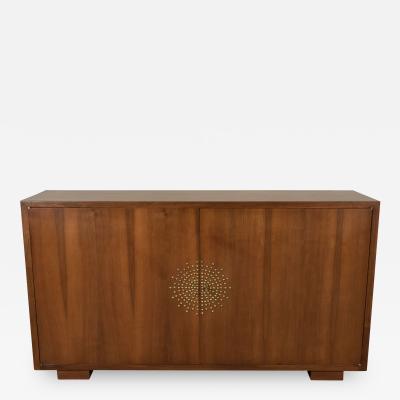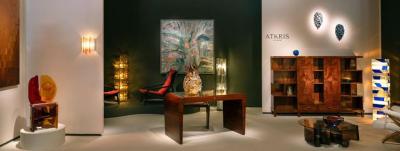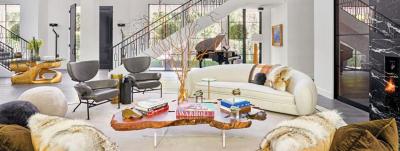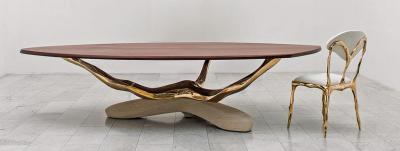Designers Sandra Nunnerley and Jamie Drake Fuse Traditional Interiors with Contemporary Style
This archive article was originally published in the 8th Anniversary issue of Antiques & Fine Art magazine.
P
eople find an “eclectic environment” comforting, in the opinion of hipster hotel owner/designer Eric Goode, who, along with business partner, Sean MacPherson, has proven his point with the success of their antique-laden Bowery and Lafayette House hotels in New York City. Creating an eminently livable environment by connecting the dots in a mix and match style was also the strength of Samuel Marx, the mostly forgotten architect/designer whose work is the subject of decorative arts dealer Liz O’Brien’s Utramodern: Samuel Marx, Architect, Designer, Art Collector (Pointed Leaf Press, 2012). With his Beaux-Arts training, Marx had an unerring eye for the compositional elements that make great art in every age. “Marx bridged classicism and modern styles to produce a body of work that was gracious, sophisticated, and timeless,” writes O’Brien. Moreover, he created a style that was uniquely his without compromising the tastes of his clients. With Marx in mind, we looked for interior designers adept at uniting the current with the classic to produce a contemporary feel that doesn’t exclude comfort. Here are a couple that caught our eye.
Sandra Nunnerley, Inc.
41 East 57th Street, New York, NY 10022
ph. 212.826.0539; fax. 212.826.1146
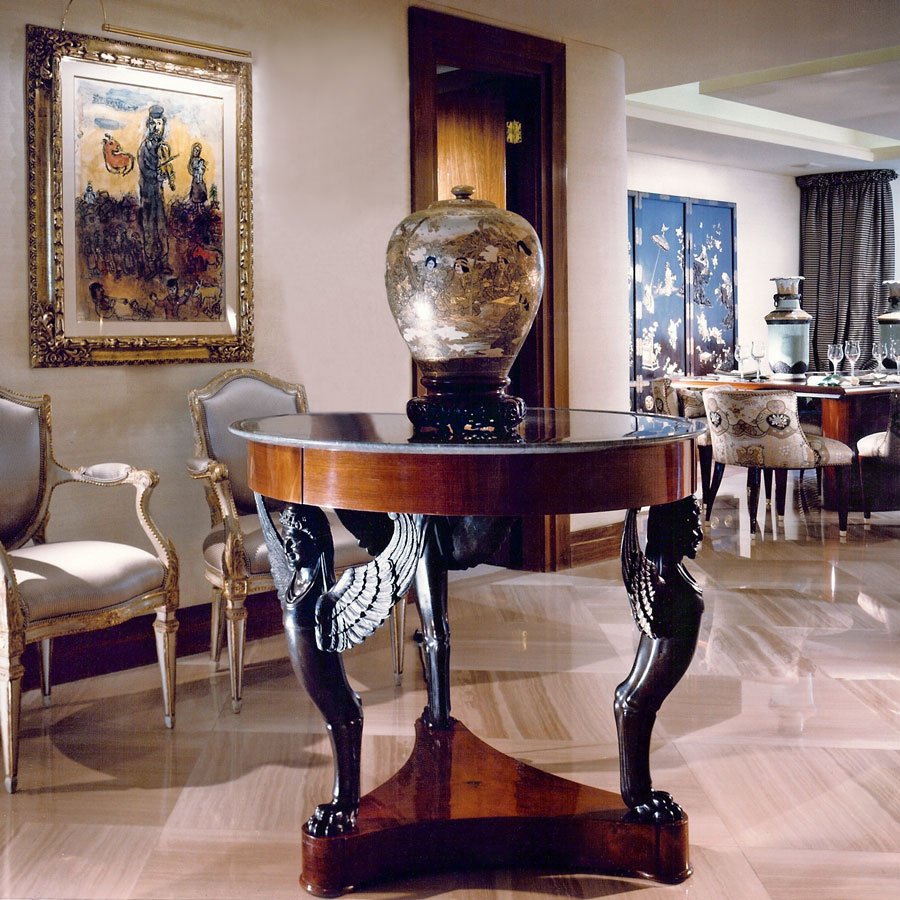 |
| Photography by Jamie Ardiles-Arce |
Although there is nearly a twenty-year gap between the two projects shown here, the same sensibility, one that Sandra Nunnerley describes as “international,” pervades both. In the late 1980s she overhauled what was once a traditional 5th Avenue apartment to create a stunning pied-à-terre with a view of the polar bears in Central Park Zoo. Clean modern lines were achieved by removing the original dividing walls to take full advantage of incoming light. Floors of polished pale marble and walls upholstered in raw silk create an uncluttered backdrop to the client’s collections of oriental and modernist art. In the foreground, a Japanese Satsuma koro form by Bai Get Su Gay, circa 1871, sits on the mahogany and bronze Empire gueridon attributed to Jean-Demosthène Dugourc (1749–1825). To the left, the frame of a lively gouache by Marc Chagall (1887–1985) entitled La Fête au Village echoes the carving on a pair of bergeres with a Swedish provenance from Florian Papp, New York. In the dining area, the wall mounted nineteenth-century Shibayama-style screens, with inlay of mother of pearl and semi-precious stones, play off the more subdued shades of the custom-designed dining table and the custom-made chairs covered with fabric from Clarence House.
 |  | |
| Photography by Jamie Ardiles-Arce | Photography by Jamie Ardiles-Arce |
The same air of quiescent luxury pervades the second interior, Nunnerley’s own apartment, which she created in 2005 by converting two apartments into one in a New York townhouse. Harnessing the living/dining area, which is a perfect square, is a Maison Jansen table, circa 1950, surrounded by Jean-Michel Frank (1895–1941) chairs. The table’s wheels allow it to function in different spaces, depending on the occasion. High ceilings show off the Jean Royère (1902–1981) sculptural chandelier, circa 1940s. The neutral walls and pale oak floors summon up Syrie Maugham’s famous white and beige London drawing room, and the custom-made couch is based on a Syrie Maugham design. Two period Louis XVI bergeres meet on either side of plexiglass tables, reflecting Nunnerley’s love of playing “up and down the scale” when it comes to interiors. Richard Serra’s My Curves Are Not Mad above the sofa and the antique Sepik River tribal piece, to the right, are a perfect example of this designer’s ability to find continuity between the past and the present.
Jamie Drake of Drake / Anderson
315 East 62nd Street, New York, NY 10021
ph: 212 754 3099; fax: 212 754 4389
“Life is eclectic and design should reflect it,” is one of the maxims espoused by Jamie Drake, who launched Drake Design Associates in 1978 just after graduating from Parsons School of Design. His flair for bold — some might say — fearless color is one of the keys to his success in investing traditional spaces with a contemporary feel and vice versa. His exuberant interior compositions have earned him commissions from the likes of Madonna, for whom he designed a showplace in Los Angeles, as well as numerous projects for New York Mayor Michael Bloomberg, including a recent renovation of Gracie Mansion, the official residence of the mayor of that city.
 |
Photography by William Waldron |
For this client who has a great fondness for bold pieces full of personality, Drake has played on the glamour of gold. The Empire gilt-bronze dining table, attributed to George-Alphonse Jacob, holds a French silver and gilt centerpiece by Jean-Baptiste-Gustave Odiot, 1869, and a pair of George III soup tureens by Thomas Heming, London, 1780. The dining chairs are George III rosewood, circa 1800. The drama of the room is given added dimension by the early-nineteenth-century Russian ormolu and cut glass chandelier, circa 1820. Another attention getter is the Russian gilt-bronze kolyvan porphyry vase, designed by Andrei Voronikhin, circa 1805, mounted on a nineteenth-century Italian gray scagliola column pedestal. A European Axminster carpet, circa 1870s, covers the floor. The English gilt-bronze mounted ebony pietre dure and porphyry sideboard is attributed to Robert Hume, circa 1830. Two prancing pottery horses, Tang dynasty, 618–907 AD, share the sideboard with an Empire silver-gilt centerpiece. Ormolu three-light Louis XVI French gilt-bronze sconces, circa 1775, provide the perfect foil for Hans Hoffman’s Towering Clouds, circa 1958.
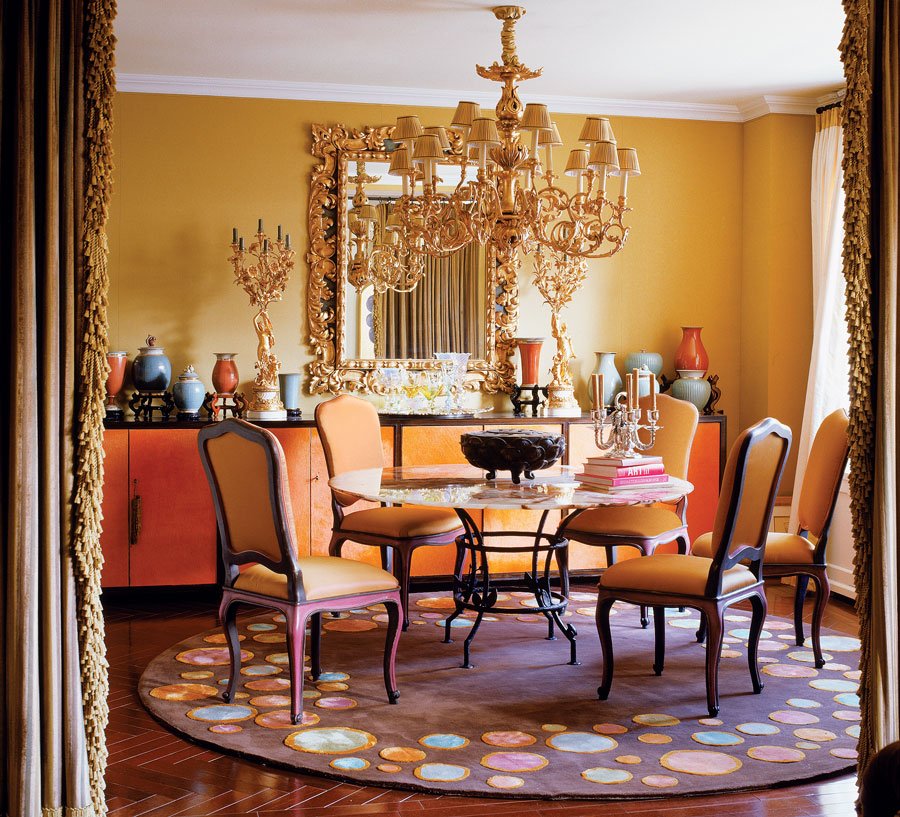 |
Photography by William Waldron |
Stately in its own way is this second dining room created for another client. A palette of luscious colors combine with the Baroque style giltwood chandelier, Austria, circa 1925, and a mid-nineteenth-century carved giltwood mirror to create the effect. The walls, upholstered in taffeta, provide a calm background to the client’s collection of Royal Copenhagen vases dating between 1930–1940s. The rug is custom-colored “Cabachon” silk from Jamie Drake Collection, and the sideboard, mahogany with orange-dyed pony skin fronted doors, is also by Drake Design.
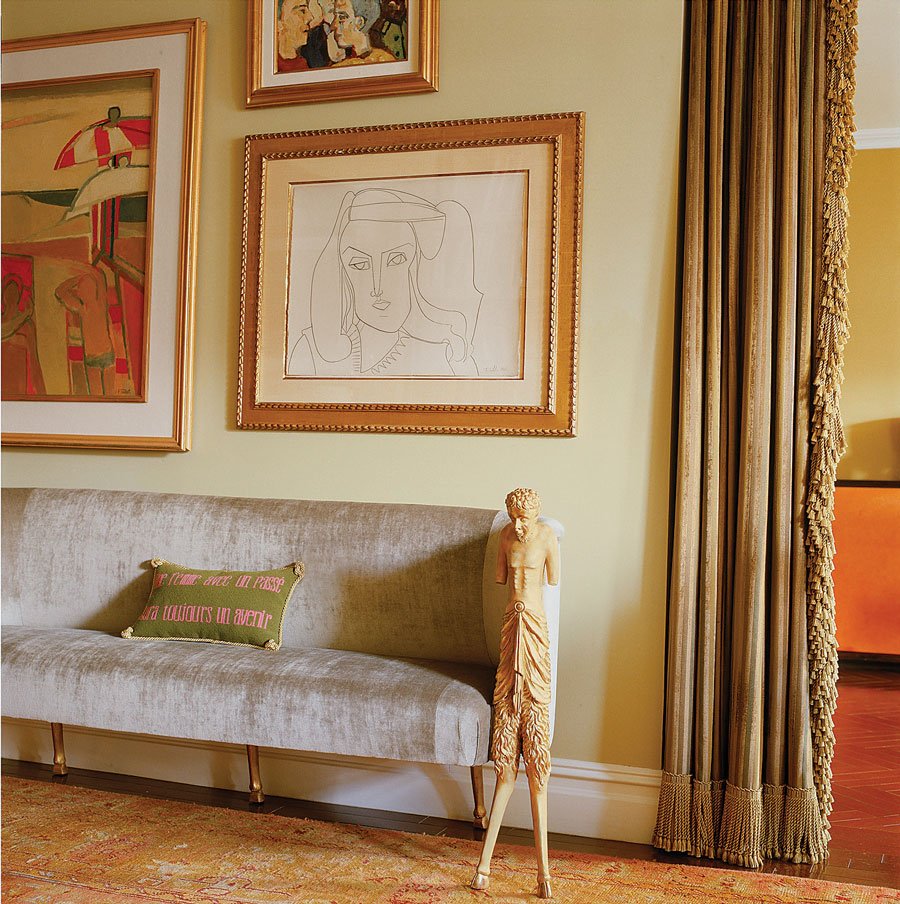 |
Photography by William Waldron |
In this detail of an adjoining room, three paintings, one by the client’s nephew and two by Francoise Gilot (born 1921), mother of Picasso’s two children Claude and Paloma, look down upon a late-eighteenth-century Italian settee.
This article was originally published in the 8th Anniversary (January-February 2008) issue of Antiques & Fine Art magazine, a fully digitized version of which is available at afamag.com. AFA is affiliated with Incollect.


















